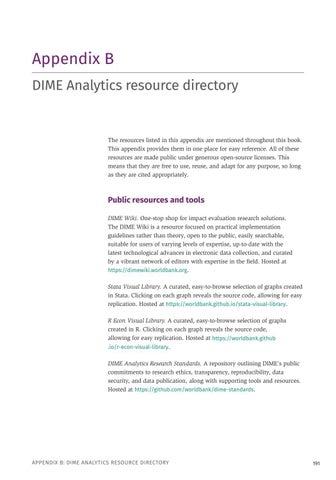Appendix B DIME Analytics resource directory
The resources listed in this appendix are mentioned throughout this book. This appendix provides them in one place for easy reference. All of these resources are made public under generous open-source licenses. This means that they are free to use, reuse, and adapt for any purpose, so long as they are cited appropriately.
Public resources and tools DIME Wiki. One-stop shop for impact evaluation research solutions. The DIME Wiki is a resource focused on practical implementation guidelines rather than theory, open to the public, easily searchable, suitable for users of varying levels of expertise, up-to-date with the latest technological advances in electronic data collection, and curated by a vibrant network of editors with expertise in the field. Hosted at https://dimewiki.worldbank.org. Stata Visual Library. A curated, easy-to-browse selection of graphs created in Stata. Clicking on each graph reveals the source code, allowing for easy replication. Hosted at https://worldbank.github.io/stata-visual-library. R Econ Visual Library. A curated, easy-to-browse selection of graphs created in R. Clicking on each graph reveals the source code, allowing for easy replication. Hosted at https://worldbank.github .io/r-econ-visual-library. DIME Analytics Research Standards. A repository outlining DIME’s public commitments to research ethics, transparency, reproducibility, data security, and data publication, along with supporting tools and resources. Hosted at https://github.com/worldbank/dime-standards.
Appendix B: DIME Analytics Resource Directory
191





